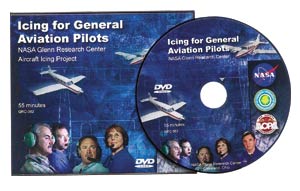
By Ryan Ferguson
| Pros: |
A comprehensive education about aircraft icing in about an hour... admission $5.00. |
| Cons: |
Lame acting |
| Bottom line: |
Any serious pilot should own this DVD. |
| Rating: |
     Five stars (out of five)
Five stars (out of five) |
|
|
My favorite aviation author and instructor, Bob Gardner, led me to this DVD by way of a newsgroup message:
"I've just finished viewing the NASA DVD on airframe icing that I got from Sporty for $4.75 plus shipping, and it should be in every instrument student's/pilot's reference library. It does a great job of illustrating the problems faced by pilots of both known-ice and uncertificated airplanes but is an excellent primer on IFR communications...especially when it comes to pilot assertiveness in dealing with ATC. It is Sporty's item D-410. I have been a student of airframe icing for a good many years, have lectured on the subject at OSH and have attended several FAA icing conferences in DC, so I feel a little more knowledgeable on the subject than most instructors...and I'm telling you, you have to get this."
 Needless to say, I immediately surfed over to Sporty's and placed my order. Aircraft icing is a subject about which a pilot can never learn enough, and five dollars is a very reasonable investment in knowledge which can save lives.
Needless to say, I immediately surfed over to Sporty's and placed my order. Aircraft icing is a subject about which a pilot can never learn enough, and five dollars is a very reasonable investment in knowledge which can save lives.
Watching the DVD
In a word, this video is excellent in nearly every way. From re-enactments of actual icing encounters to de-iced and unprotected airplane ice strategies, to demonstrations of tailplane stalls and the appropriate recovery methods, this video is a comprehensive overview of aircraft icing as it pertains to general aviation pilots. But let's get the negatives out of the way: the people in this video are pilots, not actors. Very, very droll stuff, even in the re-enactments, so you have to use your imagination a bit to suspend disbelief… but that's such a minor negative in the grand scheme that it's essentially irrelevant. This isn't entertainment, it's knowledge.
The DVD is worth it for the extra sub-section on tailplane icing/stalls alone. Via wind tunnel demonstrations, animated computer graphics, and NASA test pilot interviews, your knowledge about tailplane icing will grow in leaps and bounds. For example, did you know that in a tailplane stall, the proper recovery method is essentially the opposite of a wing stall? Instead of releasing back pressure or applying forward yoke/stick, additional back pressure is required. Instead of adding power, you reduce power. And if flaps are deployed, retract them.
"Think about it: have you ever discussed tailplane stall recovery with your CFI? If you have, congratulations – your instructor is very thorough. If not, join the club."
The reasons for this are varied, but the reality is that the pilot has very little time to decide what type of stall he's experiencing and why. Another good tip I learned from the DVD: to differentiate between a wing stall and a tailplane stall, determine whether the "buffet" is being felt in the yoke alone, or the wings. If you're not feeling the buffet in your seat, chances are good that your horizontal stabilizer is approaching a stall. Think about it: have you ever discussed tailplane stall recovery with your CFI? If you have, congratulations – your instructor is very thorough. If not, join the club. I daresay that the vast majority of instrument-rated GA pilots would be very confused if they encountered a tailplane stall.
The DVD covers two separate, but similar, flights in IMC conditions. The pilot of a Saratoga, which provides for no ice protection, strategizes his IFR cross-country flight on the ground and then we follow along to see the outcome; the pilot of a Seneca V, with boots, hot-props, and windshield de-ice, does the same. The video includes alternate outcomes so that the viewer can clearly see the thin line dividing 'go' from 'no-go' when it comes to flight in icing conditions.
Something I particularly liked about this DVD was that the producers portray the pilot as 'pilot in command,' not helpless to the whims of ATC. Via simple and effective radio techniques, pilots can avoid dangerous situations which, had they followed the initial instructions from ATC, might have put the safety of the flight in jeopardy.
NASA's footage of their icing research is fascinating. Cameras mounted in the cockpit and under the horizontal stabilizer show the separation of airflow as the tail begins to stall. In one integrated screen, the viewer can watch the airflow separate, the the horizon rise as the nose pitches over, and the pilot's recovery efforts. Fantastic… this is an education you simply can't afford to be without.
Full of excellent real-world weather flying tips, new information, and research data, there's no question that this video would be an excellent investment in your flying future.
Questions or comments? Email me at ryan@fergworld.com. 

